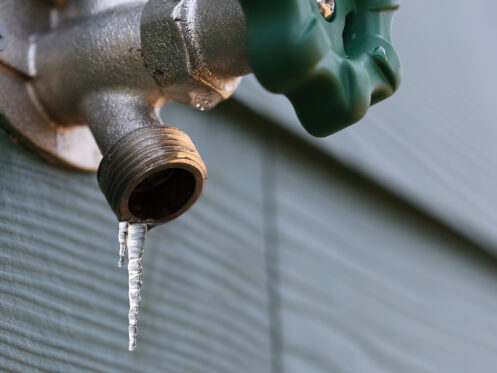Frozen pipes are something that homes can experience in areas such as Kentucky, Indiana, and Ohio. As temperatures start to drop in the fall and winter, this risk becomes more prevalent. There are also scenarios that can increase your risk of frozen pipes, such as leaving your home for an extended period while your thermostat is set to a low temperature. Let’s dive into some of the ways that you can prevent your pipes from freezing.
What Causes Pipes to Freeze?
If you are leaving on vacation or for a business trip, you may be turning your thermostat down to save energy. This can help save money, but it can also put your plumbing at risk. Even if there isn’t any water running through your pipes, the residual water that is inside your pipes could freeze. Water expands when it freezes, which puts strain on your plumbing system. In many cases, this expansion paired with cold temperatures can lead to your pipes bursting. If you’re not home and don’t discover the problem right away, you could be looking at a great deal of water damage. Fixing water damage is expensive, and water flooding your home could also cause mold growth.
Insulate Your Pipes
Insulating the area around your pipes can be beneficial in several ways. This is a great way to save money on your monthly utility bills. Insulated pipes will retain their heat better, which means your hot water heater may not run as frequently. Insulation can also protect your pipes from freezing temperatures in the home.
There are a few different products that can be used to insulate your pipes. This includes foam sleeves that fit right over your pipes. They look a lot like pool noodles that you can use as a flotation device. However, they provide valuable protection for your pipes. There are various other wraps and batting that you can have installed around your pipes. The type of product used will be determined by the accessibility of the pipes, how much insulation protection you need, and your budget.
Promote Air Flow Around Pipes
If you’re maintaining a good air temperature inside of your home, make sure that this conditioned air can circulate around your pipes. You can open cabinets and vanities to allow warm air to enter your plumbing. This is an exceptionally important process to use if you have sinks that are located on an outside wall.
Let Your Faucets Trickle Water
You only need a slow trickle of water to prevent pipes from freezing. If you know that you’re going to be away from the home or that your interior temperature is putting your plumbing at risk, open your faucets to let a little water come out. While this will increase your water bill a bit, it protects your plumbing system in the long run.
Maintain an Optimal Indoor Temperature
The inside of your home should be kept at 68 degrees Fahrenheit, according to the United States Department of Energy. Allowing your inside temperature to drop any lower than this can affect your plumbing system and potentially cause pipes to freeze. If you are going to be away from home, using a smart thermostat can provide you with the convenience of adjusting and monitoring your indoor temperature remotely. You should never drop your indoor temperature lower than 55 degrees Fahrenheit.
Insulate Your Home
We discussed the benefits of insulating your pipes, but it’s also important to have enough insulation throughout your home. You can have our team assess your current insulation. We will help you determine if there are improvements you can make to protect your plumbing as well as your indoor air quality and comfort. We can install new insulation in areas like the attic, basement, etc.
Seal up Your Home
Even if you have your thermostat set at a desirable temperature, there may be cold air leaking into your home through various gaps and cracks. These spaces can form around windows, doors, your foundation, etc. Not only will this cold air put your pipes at risk of freezing, but this can also impact your indoor air quality and comfort as well.
Thawing Frozen Pipes
If you discover that one or more of your pipes have frozen, you’ll want to be very cautious with thawing them. Some signs to watch out for that indicate a frozen pipe include:
- A slow trickle or no water coming from the faucet
- Visible ice or condensation on the outside of the pipe
- Bulges on the outside of the pipe
- Odd sounds like clanking or gurgling
If you notice that there is physical damage to the pipe and water is leaking out of it, you’ll want to shut off the main water valve to this area. Reach out to a professional for assistance with repairing the problem. Otherwise, you may be able to turn the water on slightly, so water starts to thaw the ice that is inside the system.
If a large amount of ice has formed and you don’t have ample water flow, heat the outside of the pipe. Make sure that you aren’t applying too much heat at once. A blow dryer is a convenient tool to effectively thaw your pipes. You can also wrap your pipes in towels that have been soaked in hot water.
You should also bring the temperature of your home back to a higher reading if it was previously set low. This can help promote a slow thawing process from the outside in.
In the meantime, check the rest of your home’s plumbing system to determine if any other pipes have frozen. If it appears that you have large sections of your system that are frozen, you’ll need the assistance of our team to get your plumbing system back in working order.
Do All Pipes Freeze?
Pipes made of plastic, copper, steel, and other materials can freeze. Whether or not your pipes burst when they’re frozen will often depend on the material they are made of and how structurally sound your plumbing system is. An annual inspection of your plumbing can help spot high-risk areas and damaged pipes. We can perform pipe repairs and upgrades as needed if you’re concerned about your pipes freezing in the winter.
If you are interested in learning more about the various ways that you can prevent your pipes from freezing this winter in Kentucky, Indiana, or Ohio, reach out to our team here at Bryant Heating, Cooling, Plumbing & Electric. In addition to protecting your plumbing, we also install, repair, and maintain different types of heating and cooling equipment. We can service your water heater, unclog your pipes, work on your sump pump, install plumbing, and much more. We also provide electrical services, including the installation of EV chargers, new wiring, panel upgrades, generator installation, electrical inspections, etc. Contact Bryant Heating, Cooling, Plumbing & Electric today to schedule an appointment.



